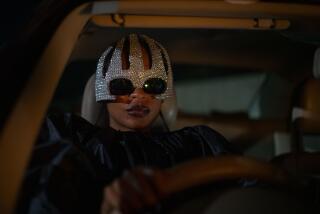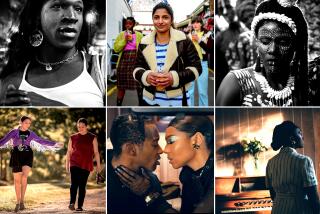In step with the times
THE satisfactions of dance have often been MIA at Dance Camera West, an annual local film festival obsessed, year after year, with camera and editing fripperies to the virtual exclusion of movement skill or invention.
But not anymore. In its fifth edition, the monthlong event -- scheduled at venues downtown, in Westwood and in Santa Monica -- teems with strong creative collaborations between filmmakers and choreographers.
It comprises 50 films -- the longest nearly two hours, the shortest barely three minutes -- that, taken together, reflect completely different priorities from those that dominated previous festivals.
For instance, endless variations on rolling in the grass have apparently lost their fascination in the world of dance cinema, and similarly, the sight of Botticellian babes drifting through misty woods or surf is also now suddenly passe.
You can explain the change by speculating that the cliche of shooting any kind of movement, cutting it to music and calling the result a dance film excites nobody these days except possibly the neophytes in Camcorder 101 -- and it’s about time.
But the answer goes deeper: Most of the new films being screened were conceived and realized after the horrifying terrorist attacks in New York, Washington, D.C., London and Madrid signaled a different kind of future for everyone.
Responding to the zeitgeist, dance-for-camera artists everywhere have stopped making perky little showpieces designed to get them jobs shooting commercials or music videos and tried to catch the dark, worrisome mood they wake to every morning.
Many have returned to storytelling as a way of making that mood explicit. Others now trust the body of the dancer to express the constellation of feelings that define this moment in history. So even when, inevitably, a Dance Camera West short film turns out to be boring, it’s now more pertinently boring than before -- and that’s a plus.
There are other ways many of these films are alike, some coincidental (all the dances set in bathrooms, for instance), others based on the inescapable influence of Hollywood (the reliance on special effects). But if you had to put a label or title on Dance Camera West 2006, it might be “Running Scared.” This year, all the energy that filmed dance can depict and generate is aimed at the shattering of complacency.
What’s more, besides filling the scheduled screenings with an unusually impressive international sampling of dance for the camera, festival director Lynette Kessler is experimenting with presentation formats such as gallery installations and the interaction of live dancers with film images.
If there’s a loss, it’s the absence of feature-length documentaries, in which, ironically, most of the dance content of past festivals was concentrated. Except for a few shorts, the sole example this year is a fine profile of postmodern pioneer Rudy Perez, “Countdown: Reflections of a Life in Dance,” previously reviewed in these pages.
In a position paper or introduction to the festival, Kessler avoids the D-word and speaks of “physical expression and visual media,” “audiovisual culture” and other terms that bypass the troublesome fact that those artists generally recognized as the greatest dancers and choreographers of our time seldom participate in dance-film projects except when those projects preserve the artists’ theatrical achievements.
We’ve all winced at the extremes that powerful choreographers and filmmakers impose: photographed transcriptions of stage performances with no filmic interest versus MTV-style jumbles of quick cuts that leave movement continuity fatally dismembered.
This situation is slowly changing, and Dance Camera West reflects that change in adventuresome films featuring the work of celebrated contemporary choreographers and companies. It’s still much easier for emerging dance makers to accept a director’s vision than for the lions of dance to surrender their autonomy. But the best of DCW ’06 reflects a sense of growing trust and shared goals that may well result in the exciting fusion of arts that Kessler claims already exists.
Most of the films will be on view at four downtown REDCAT screenings next weekend and on monitors in the Hammer Museum Courtyard in Westwood on June 10 and 15. However, Carlos Saura’s haunting, feature-length “Tango” is being shown June 21 at the Max Palevsky Theatre at the Aero in Santa Monica. And DCW offshoots will be found during the Los Angeles Film Festival (Wednesday at the Landmark Regent) and in the Grand Performances series (Aug. 5 at the Watercourt in California Plaza). Details are available at www.dancecamerawest.org and the websites of the various venues.
Segal is The Times’ dance critic.
*
(BEGIN TEXT OF INFOBOX)
Critic’s Choice: Highlights of Dance Camera West 2006
REDCAT in
Walt Disney Concert Hall
8 p.m. Friday
“Dos Ambientes” (Argentina, 2004) Beginning with a spectacular fantasy tango inside a tiny bathroom, Rodrigo Pardo’s 15-minute dance drama also features a brutal fight-dance in a narrow kitchen and intense split-screen love duets -- all using spatial confinement to enhance the dance experience.
Funny, sexy and endlessly resourceful, the choreography conjures dancing out of alternately mundane and grim reality with great freshness.
“Burnt” (Germany, 1997) The everyday movement tasks of a cleaning woman contrast with the interpersonal choreographic manipulations and conflicts of a sleek, moneyed trio in Holger Gruss’ 15-minute parable of modern servitude.
Exploring a multistory lobby or atrium, Vera Sander’s dances adroitly showcase the technical and expressive strengths of her cast -- though why it rains only on the lone woman remains one of life’s enduring mysteries.
6:30 p.m. Saturday
“Cartographie 3/Interface” (Switzerland, 2004) One of three festival films this year that Philippe Saire choreographed in various Lausanne locations, this sly 14-minute mock-thriller shows a number of suspicious characters (including Saire) converging on a peaceful train station.
Is their dancing an innocent divertissement or some subversive red herring? Director Pierre-Yves Borgeud uses shots of a clock, views through security cameras and other suspense cliches to build tension until the train that everyone is waiting for finally arrives and the characters’ Big Plan goes into effect.
“Another” (Iceland, 2005) Shooting in an actual prison, director Rene Vilbre and choreographer Helena Jonsdottir show guards and inmates equally stifled -- and just as likely to express their repression in convulsive dances.
Quickly, this ironic, psychosexual 24-minute narrative focuses on Ruslan Stepanov, playing a prisoner so unlawfully irresistible that he bedevils two guards (male and female) who can’t seem to stay out of his cell. When is solitary confinement an invitation to party? Stepanov knows ....
8 p.m. Saturday
“No Man’s Land” (Canada, 2005) In the 1944 Hollywood feature “Cover Girl,” Gene Kelly danced a conversational duet with himself on a city street -- a vintage FX feat that Alex Oktan’s seven-minute short gracefully modernizes thanks to the talents of dancer-choreographermusician Peter Chin.
“Blush” (Belgium, 2005) With its full-frontal nudity (male and female), graphic sex and ugly violence, Wim Vandekeybus’ woozy 52-minute epic takes Dance Camera West far, far beyond its usual PG content. And much of it is just dreadful: self-enamored, incoherent, not so much over the top as under the bottom.
However, every so often you’ll find Vandekeybus’ superb Ultima Vez modern dance company delivering the most powerful performances of the festival -- if you can stand watching the cast devour live frogs (or are they toads?) and similar Wim whimsies.
Courtyard, Hammer Museum, UCLA
8 to 11 p.m. June 10
“Somewhere in Between” (France, 2004) Although the action moves from public spaces to private rooms, from Meg Stuart’s solos to larger groups of dancers, virtually each sequence in Pierre Coulibeuf’s deliberately fragmentary 70-minute social portrait is a microcosm of the whole.
Depicting a rootless, frustrated, contemporary existence punctuated with impotent rage, the film expresses the same sense of foreboding that pervades many of the festival’s recent creations -- but directly, full-on, without resorting to melodrama or any other conventional format. Not always easy to watch but consistently surprising.
“Valse Wals” (Netherlands, 2005) A tour de force for dancer-choreographers Ria Marks and Titus Tiel Groenestege, this hourlong life cycle begins with raunchy mating dances, then summarizes years of marital boredom spent in front of the TV and ends with the poignant vulnerabilities of old age.
Director Mark de Cloe enhances what might have been just a stagy three-act dance drama with imaginative special effects, location shooting -- even a runaway bed on wheels that carries Marks and Groenestege to their final destination.
7 p.m. June 15
“The Radio Ballet” (Norway, c. 2003) Using enhanced color, location shooting and realistic movement tasks that become dancelike, director Per-Ivar Jensen and choreographer Indra Lorentzen offer a charming tribute to the way that radio sound effects stimulate the imagination.
Their five-minute film comes midway through “Moving North,” a varied 10-part compendium from Scandinavia that also boasts the sexy Icelandic duet “Burst” (shown at Dance Camera West in 2004), the moody “Urge,” featuring members of the Royal Danish Ballet, and “Regin Smiour,” a look at a social dance from 12th century France that now survives only in the Faroe Islands.
-- L.S.
More to Read
Only good movies
Get the Indie Focus newsletter, Mark Olsen's weekly guide to the world of cinema.
You may occasionally receive promotional content from the Los Angeles Times.






